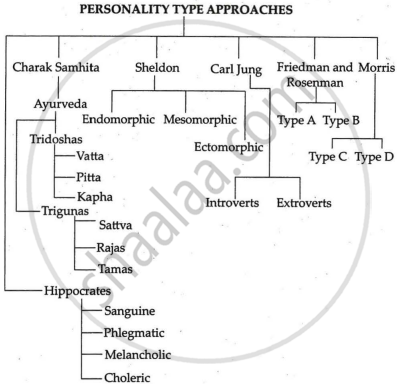Advertisements
Advertisements
प्रश्न
A number of theories have been used to understand 'personality'. Discuss how efforts have been inade to categorise people into personality types since ancient times.
उत्तर
Type theory presumes that people can be categorised into a series of categories or types based on no overlapping characteristics.

- Greek physician Hippocrates, regarded as the “father of modern medicine,” held that a person’s physical and mental health were interconnected. To extend his idea, he suggested four personality types based on the temperament’s major humour and fluids.
- Sanguine: cheerful, active and optimistic.
- Phlegmatic: touchy, sluggish, calm and apathetic.
- Melancholic: sad, broocling and morose.
- Choleric: irritable, hot-tempered and excitable.
- The three “Dashas”—Vata, Pitta, and Kapha—that make up the Indian discipline of medicine, known as Ayurveda, or Charak Samhita, are used to categorise persons.
- Based on qualities (gunas), there are three different types of personalities.
- Sattva: The qualities of sincerity, detachment, discipline, keen intelligence, self-control, and spirituality are included in the Sattva Guna.
- Rajas: Rajas Guna consists of some worldly characteristics, such as the need for instant gratification and a materialistic mindset. They are both inventive and envious.
- Tamas: The Tamas Guna is made up of all the vices in the world, including mental instability, rage, arrogance, laziness, etc.
Based on the physical constitution, Sheldon has categorised personalities.- Endomorphic: They are big, soft, and round, and they are relaxed and social, like eating and enjoying themselves.
- Mesomorphic: They have a rectangular, well-built body shape with a strong muscular structure. They are bold, energetic, assertive, and dominating.
- Ectomorphic: They have a body shape that is long, thin, and fragile. They are brainy, artistic, introvert and are fond of solitude and inward-looking.
- Carl Jung grouped all people into:
- Introverts: They are socially withdrawn, passive, quiet, cautious and reserved.
- Extroverts: Socially outgoing, talkative, impulsive and thrill-seeking.
- Meyer Friedman and Ray Rosenman (1974) identified psychological variables and suggested that individuals can be grouped into two personality types:
- Type-A: Type-A, coronary-prone behaviour pattern. They are never content, constantly pressed for time, overworked, and competitive.
- Type-B: The neutral behaviour pattern, often known as type B, is marked by an easygoing, relaxed way of life.
-
More recent research by Morris has suggested Type-C and Type-D personalities.
-
Type-C personalities are cancer-prone and are defined by their lack of aggressiveness, suppression of anger, and submission to external authorities to avoid disputes.
-
Type-D personalities are generally pessimistic and prone to depression.
-
APPEARS IN
संबंधित प्रश्न
What is trait approach to personality?
How does Freud explain the structure of personality?
How would Horney’s explanation of depression be different from that of Alfred Adler?
Anjani just found a gold bracelet inside a movie theatre. Which part of her personality would urge her to deposit it at the manager’s office?
Collective unconscious consists of _____ that are not individually acquired but are inherited.
An individual’s sole concern with the satisfaction of __________ needs would reduce him/her to the level of animals.
The b coefficient obtained in multiple regression is
Alfred Adler's theory of personality is known as:
______ are over-learned modes of behaving.
______ may be described as changes that take place in particular parts of the body and in the behavior of an organism.
______ and learning operate as dual forces in almost all cases of behavior changes.
Who first attempted to describe personality traits in terms of Lexi can descriptors?
Who constructed the personality structure: Id, Ego, and Superego?
The view that "adjustment differs from maladjustment in degree rather than in kind" is psychologically
Which famous psychologist believed in the collective unconscious?
Who said that two major components of "person's" psychology were the twin notions of basic anxiety and basic hostility?
Compensation and rationalization are examples of ______
Dr. Maki questioned a group of 9th graders about their career aspirations. This is an example of an ______
Which of the following is another term for reinforcement?
The ______ focuses on the specific psychological attributes along which individuals tend to differ in consistent and stable ways.
The ______ are stable, and are considered as the building blocks of personality.
The ______ are stable and are considered the building blocks of personality.
GAS involves three stages: alarm reaction, resistance, and ______.
Describe Freud’s psychosexual stages of personality development.
A study found that one-third of British children, at age six, are afraid of snakes even though it is rare to encounter snakes in British Isles. ‘The children had never come in contact with snakes in a traumatic situation, but snakes still generated anxious response. How would Carl Jung's theory of personality explain the same? Throw some light on his theory.
How does trait differ from type approach?
Explain any four type theories in detail.
